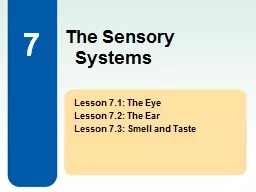

Lesson 73 Smell and Taste The Sensory Systems Lesson 71 The Eye Chapter 7 The Sensory Systems anatomy of the eye external internal vision injuries diseases and disorders of the eye The Eye ID: 932272
Download Presentation The PPT/PDF document "7 Lesson 7.1: The Eye Lesson 7.2: The Ea..." is the property of its rightful owner. Permission is granted to download and print the materials on this web site for personal, non-commercial use only, and to display it on your personal computer provided you do not modify the materials and that you retain all copyright notices contained in the materials. By downloading content from our website, you accept the terms of this agreement.
Slide1
7
Lesson 7.1: The EyeLesson 7.2: The EarLesson 7.3: Smell and Taste
The Sensory Systems
Slide2Lesson 7.1
The Eye
Chapter 7: The Sensory Systems
Slide3anatomy of the eyeexternalinternal
visioninjuries, diseases, and disorders of the eyeThe Eye
Slide4tarsal glands
ciliary glandsExternal Structures of the Eye
conjunctiva
lacrimal glands
Slide5Extrinsic Muscles
Slide6Slide7humorsaqueousvitreous
tissue layersscleracorneachoroidpupilirisretinarods and cones
Internal Structures of the Eye
Slide8Internal Structures of the Eye
Slide9Vision Disorders
Slide10Internal Structures of the Eye
Slide11retinaimpulseoptic nerve
brainoptic chiasmaoptic tractsoccipital lobeVision
Slide12Vision Disorders
Slide13Vision Disorders
Slide14conjunctivitisalso known as pink eye
cataractsglaucomamacular degenerationdiabetic retinopathyvitreous floatersEye Diseases
Slide15Fill in the blanks with: choroid, cornea, cones, or vitreous. 1. The pupil is part of the _______________ tissue layer.
2. The two humors are aqueous and _______________.3. The retina contains the rods and _______________.4. The clear part of the sclera is the _______________.
Review and Assessment
Slide16Light enters through the CORNEA (which also protects the eye)
Light then moves through PUPIL (black circle in center of eye) which helps the light move through the lens.The IRIS(colored part of the eye), helps the pupil constrict or dilate, depending on the amount of light. There are two muscles in the iris: SPHINCTER PUPILLAE (contracts with bright light and pupil gets smaller) and DILATOR PUPILLAE (dilates with dim light and pupil gets larger)
The lens focuses light rays on to the back of the eyeball (RETINA). The image falls on the retina upside down and the brain turns it right side up so that you the image correctly.
The impulse leaves the eyeball through the OPTIC NERVE and travels to the OCCIPITAL LOBE where the impulse is interpreted.
Path of light ray through the eyeball.
Slide17Lesson 7.2
The Ear
Chapter 7: The Sensory Systems
Slide18anatomy of the earfunctions of the eardisorders and infections of the ear
The Ear
Slide19external earauricle, auditory canal, and tympanic membranemiddle ear
ossicleshammer, anvil, and stirrupEustachian tubeinternal earcochlea, vestibule, and semicircular canals
Anatomy of the Ear
Slide20Anatomy of the Ear
Slide21Anatomy of the Ear
Slide22Hearing - Equilibrium – hair cells, cochlear
duct semicircular canalsFunctions of the Ear
Slide23deafnesstinnitusexternal otitis (swimmer’s ear)
otitis media (middle ear infection)labyrinthitis (inner ear infection)Disorders and Infections of the Ear
Slide24True or False?1. External otitis is swimmer’s ear.
2. The ossicles are in the external ear.3. Hair cells are responsible for equilibrium. 4. The cochlea is part of the inner ear.5. Labyrinthitis is an inner ear infection.
Review and Assessment
Slide25Lesson 7.3
Smell and Taste
Chapter 7: The Sensory Systems
Slide26olfactory sense (sense of smell)injuries and disease of the nosegustatory sense (sense of taste)
disorders of the tongueSmell and Taste
Slide27olfactory regionolfactory receptor cellsolfactory hairs
olfactory filamentsolfactory nerveolfactory bulbOlfactory Sense
Slide28Olfactory Sense
Slide29rhinitisinflammation of nasal membraneseptum problems
deviated septumInjuries and Disorders of the Nose
Slide30taste budspapillaegustatory cells
gustatory hairstaste porestastantsGustatory Sense
Slide31infectionseverely bitten tongue during a traumatic accidenttongue piercing
injuryabnormal growthhairy tongueburning mouth syndromeDisorders of the Tongue
Slide32Match these words with 1–4 below: gustatory, gustatory hairs, olfactory hairs, rhinitis.1. inflammation of the nasal membrane
2. sense of taste 3. part of taste bud 4. part of sense of smell Review and Assessment